① Linearly Ordered Palladium Complexes Supported by Tetradentate Phosphine Ligands
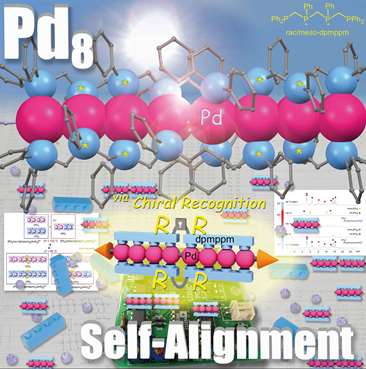
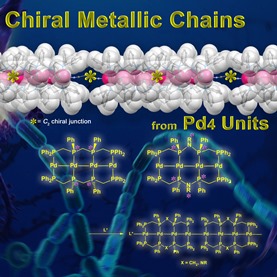
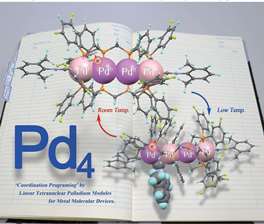
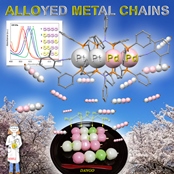
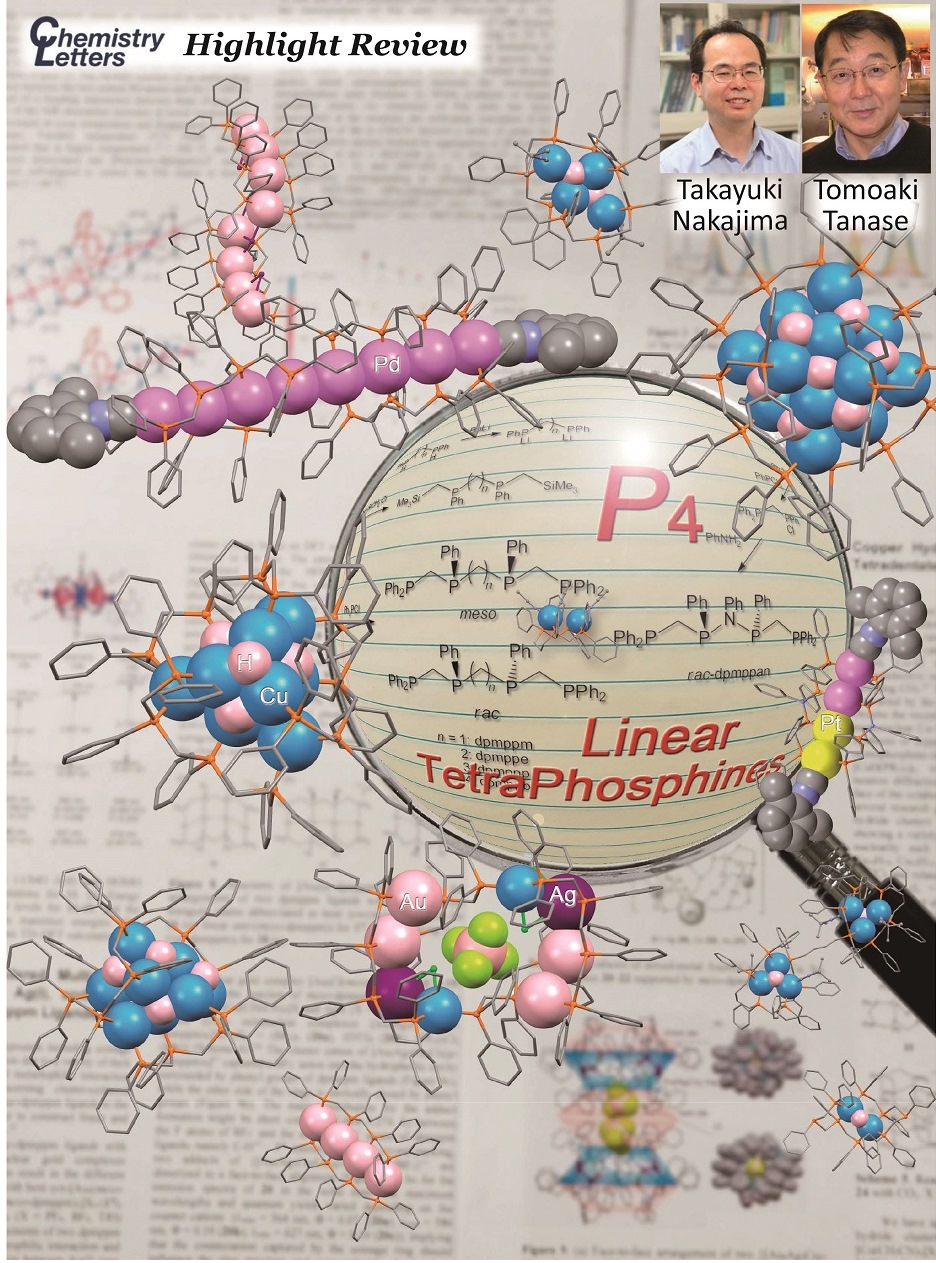
References


1.Synthesis of Linearly Ordered Multinuclear Complexes Designed to Applications
for Nanoscale Molecule Devices
2.Development of New Reactions with Multinuclear Active Centers
① Linearly Ordered Palladium Complexes Supported by Tetradentate Phosphine Ligands





References
T. Tanase, K. Nakamae, S. Hayashi, A. Okue, R. Otaki, T. Nishida, Y. Ura, Y. Kitagawa, T. Nakajima T. Tanase, K. Yamamoto, R. Hatano, K. Nakamae, B. Kure, Y. Ura, T. Nakajima,
go to TOP 2. Development of New Reactions with Multinuclear Active Centers
Transition metals have their own unique reactivities and are widely used as catalysts for mass production of medicine, agrichemicals,
and electronic materials in the industrial chemistry. However, these catalysts are heterogeneous noble metal solid compounds or mononuclear complexes in many cases.
In contrast, transition-metal clusters have attracted considerable interest due to not only surface models of solid catalyst, but also their diverse properties such as catalyst,
electronic, and magnetic devices induced by synergistic effects between adjacent metal centers.
Our group has synthesized various homo- and heteromultinuclear structures supported by multidentate phosphine-based ligands, aiming to develop environmentally benign
and energy saving catalytic processes. Especially, cheap and abundant copper metal clusters have attracted growing attention as base metallic materials alternative to
rare and noble metals. We have recently found reduction of CO2 to formic acid under mild condition by a dinuclear copper hydride complex and reversible dioxygen binding on
dinuclear rhodium centers.
go to TOP
“Chiral Octapalladium Chains Supported by Enantiopure P-Stereogenic Linear Tetra-phosphines, (R,R)- and (S,S)-Ph2PCH2P(Ph)CH2P(Ph)CH2PPh2”
Inorg. Chem. 60 (2021) 3259-3273.
T. Nakajima, K. Nakamae, Y. Ura, T. Tanase
“Multinuclear Copper Hydride Complexes Supported by Polyphosphine Ligands”
Chem. Lett. 2020, 49, 386-394. [Outside Back Cover Picture]
T. Tanase, M. Tanaka, M. Hamada, Y. Morita, K. Nakamae, Y. Ura, T. Nakajima
“Alloyed Tetranuclear Metal Chains of Pd4-nPtn (n = 0-3) Scaffolded by a New Linear Tetraphosphine Containing a PNP Bridge”
Chem. Eur. J. 25 (2019) 8219-8224. [Front Cover Picture]
T. Tanase, K. Morita, R. Otaki, K. Yamamoto, Y. Kaneko, K. Nakamae, B.
Kure, T. Nakajima,
“Chiral Self-Recognition between Stereogenic Tetrapalladium Units Affording
Pd8 Chains Supported by Homochiral Tetraphosphines”
Chem. Eur. J. 23, 524-528 (2017) .[Back Cover Picture]
K. Nakamae, Y. Takemura, B. Kure, T. Nakajima, Y. Kitagawa, T. Tanase,
“Self-Alignment of Low-Valent Octanuclear Palladium Atoms”
Angew. Chem. Int. Ed. 54, 1016-1021 (2015).
T. Tanase, S. Hatada, S. Noda, H. Takenaka, K. Nakamae, B. Kure, T. Nakajima,
“Stepwise Expansion of Pd Chains from Binuclear Palladium (I) Complexes
Supported by Tetraphosphine Ligands”
Inorg. Chem. 54, 8298-8309 (2015).
T. Tanase, S. Hatada, A. Mochizuki, K. Nakamae, B. Kure, T. Nakajima,
“Flexible, Linear, Tetranuclear Palladium Complexes Supported by Tetraphosphine
Ligands with Electron-withdrawing Groups”
Dalton Trans. 42, 15941-15952 (2013). [Inside Cover Picture]
② Linearly Ordered Platinum Complexes Supported by Tridentate Phosphine Ligands
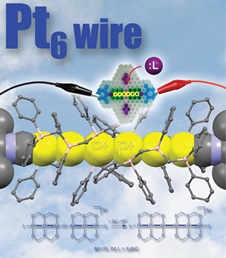
 Eur. J. Inorg. Chem. 2017, 1422-1426 by Tanase-1.jpg)
References
“Linear Triplatinum Tetrahydride Complex Supported by Triphosphine Ligands,
[Pt3(µ-H)2(H)2(µ-dpmp)2](BF4)2 {dpmp = bis(diphenylphosphinomethyl)phenylphosphine}”
Eur. J. Inorg. Chem. 1422-1426 (2017). [Cover Picture]
T. Tanase, K. Koike, M. Uegaki, S. Hatada, K. Nakamae, B. Kure, Y. Ura,
T. Nakajima
“Electron-rich Linear Triplatinum Complexes Stabilized by a Spinning Tetraphosphine,
tris(diphenylphosphinomethyl)phosphine”
Dalton Trans. 45, 7209-7214 (2016).
E. Goto, R. A. Begum, C. Ueno, A. Hosokawa, C. Yamamoto, K. Nakamae, B. Kure, T. Nakajima, T. Tanase,
“Electron-Deficient Pt2M2Pt2 Hexanuclear Metal Strings (M = Pt, Pd) Supported
by Triphosphine Ligands”
Organometallics 33, 1893-1904 (2014).[Cover Picture]
E. Goto, R. Begum, A. Hosokawa, C. Yamamoto, B. Kure, T. Nakajima, T. Tanase,
“Hybride-bridged Pt2M2Pt2 Hexanuclear Metal Strings (M = Pt, Pd) Derived from Reductive Coupling of Pt2M Building Blocks Supported by Triphosphine Ligands”
Organometallics, 31, 8482-8497 (2012).
A. Hosokawa, B. Kure, T. Nakajima, K. Nakamae, T. Tanase
“Intermolecular Metal-Metal Bond Rearrangement in a Pt2PdHg Heterometallic
Cluster Forming a HgI-PdI Covalent Bond”
Organometallics 30, 6063-6066 (2011). [Showcase Featured Paper]
E. Goto, R. A. Begum, S. Zhan, T. Tanase, K. Tanigaki, and K. Sakai
“Linear Redox-Active Pt6 and Pt2Pd2Pt2 Clusters”
Angew. Chem. Int. Ed., 43, 5029-5032 (2004).
③ Synthesis and Photophysical Property of Multinuclear Complexes of Group 11 Element Supported by Multidentate Phosphine Ligands
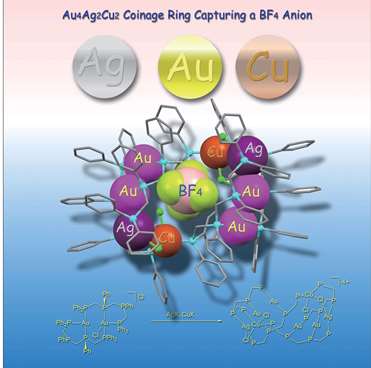
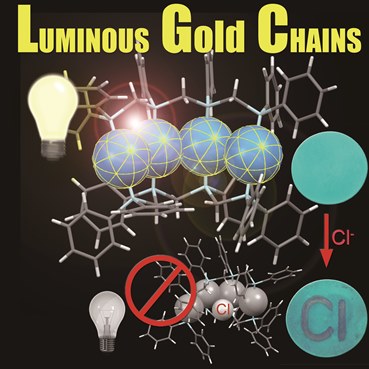
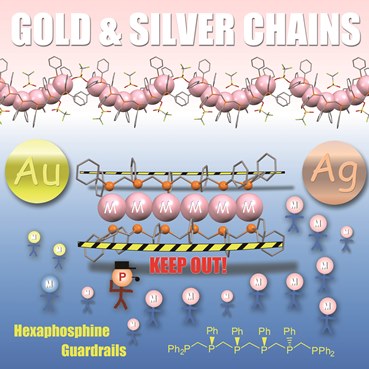
References
T. Tanase, M. Chikanishi, K. Morita, K. Nakamae, B. Kure, T. Nakajima,
“Gold and Silver Chains Supported by Linear Hexaphosphine Ligands”
Chem. Asian J. 10, 2619-2623 (2015).
T. Tanase, R. Otaki, T. Nishida, H. Takenaka, Y. Takemura, B. Kure, T.
Nakajima, Y. Kitagawa, T. Tsubomura,
“Strongly Luminous Tetranuclear Gold(I) Complexes Supported by Tetraphosphine Ligands, meso- or rac-Bis[(diphenylphosphinomethyl)phenylphosphino]methane”
Chem. Eur. J. 20, 1577-1596 (2014).
Y. Takemura, T. Nishida, B. Kure, T. Nakajima, M. Iida, and T. Tanase
“Stepwise Construction of Au4Ag4Cu2 Coinage Rings Supported by Linear Tetraphosphine
Ligands”
Chem. Eur. J. 17, 10528-10532 (2011). [Inside Cover Picture]
Y. Takemura, T. Nakajima, T. Tanase
“Interconversion between ladder-type octanuclear and linear tetranuclear copper(I) complexes supported by tetraphosphine ligands”
Dalton Trans. 10231-10243 (2009). [Hot Paper]
Y. Takemura, H. Takenaka, T. Nakajima, and T. Tanase
“Hexa- and Octagold Chains from Flexible Tetragold Molecular Units Supported
by Linear Tetraphosphine Ligands”
Angew. Chem. Int. Ed. 48, 2157-2161 (2009).
Y. Takemura, T. Nakajima, and T. Tanase
“Synthesis and Characterization of Linear Tetranuclear Silver(I) Complexes
Bridged by Tetraphosphine Ligands”
Eur. J. Inorg. Chem. 4820-4829 (2009).
① Reductions by Copper Hydride Clusters Supported by Multidentate Phosphine Ligands
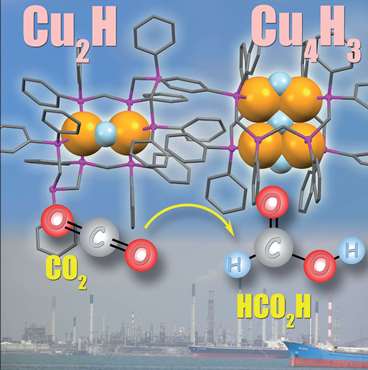
 cej201702071 Cover-1.jpg)

References
T. Nakajima, K. Nakamae, Y. Ura, T. Tanase
“Multinuclear Copper Hydride Complexes Supported by Polyphosphine Ligands”
Eur. J. Inorg. Chem. 23 (2020) 2211-2226. [Outsude Front Cover Picture]
K. Nakamae, T. Nakajima, Y. Ura, Y. Kitagawa, T. Tanase
“Facially Dispersed Polyhydride Cu9 and Cu16 Clusters Comprising Apex-Truncated Supertetrahedral and Square-Face-Capped Cuboctahedral Copper Frameworks”
Angew. Chem. Int. Ed. 59 (2020) 2262-2267. [Front Cover Picture]
T. Tanase, R. Otaki, A. Okue, K. Nakamae, T. Nakajima
“Dinuclear Copper Complexes Triply Bridged by a Tetraphosphine, rac-Ph2PCH2P(Ph)CH2P(Ph)CH2PPh2”
Eur. J. Inorg. Chem. (2019) 3993-4005.
T. Nakajima, K. Nakamae, R. Hatano, K. Imai, M. Harada, Y. Ura, T. Tanase
“Tetra-, hexa-and octanuclear copper hydride complexes supported by tridentate phosphine ligands”
Dalton Trans. 48 (2019) 12050-12059.
T. Nakajima, Y. Kamiryo, M. Kishimoto, K. Imai, K. Nakamae, Y. Ura, T. Tanase
“Synergistic Cu2 Catalysts for Formic Acid Dehydrogenation”
J. Am. Chem. Soc. 141 (2019) 8732-8736.
K. Nakamae, M. Tanaka, B. Kure, T. Nakajima, Y. Ura, T. Tanase
“A Fluxional Cu8H6 Cluster Supported by Bis(diphenylphosphino)methane and
Its Facile Reaction with CO2 “
Chem. Eur. J. 23, 9457-9461 (2017). [Inside Cover Picture]
K. Nakamae, B. Kure, T. Nakajima, U. Ura, T. Tanase,
“Facile Insertion of Carbon Dioxide into Cu2(m-H) Dinuclear Units Supported
by Tetraphosphine Ligands”
Chem. Asian J. 9, 3106-3110 (2014). [Inside Cover Picture]
② Activation of Small Molecules by Heterodinuclear Complexes Supported by Multidentate Phosphine-based Ligands
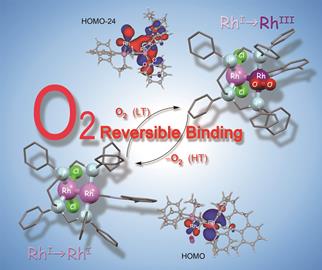
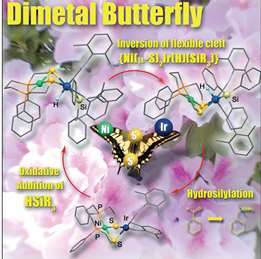
References
B. Kure, M. Sano, N. Watanabe, T. Nakajima, T. Tanase
“Synthesis and Reactivity of Thiolate-Bridged NiIIMI Heterodinuclear Complexes (M = Rh, Ir) with an S-Bidentate NiP2S2 Metalloligands”
Eur. J. Inorg. Chem. 4097-4109 (2017). [Cover Picture]
T. Nakajima, S. Noda, M. Sakamoto, A. Matsui, K. Nakamae, B. Kure, Y. Ura
and T. Tanase
“Oxidative Addition of Aromatic ortho C‒H Bond of Tetraphosphine to Asymmetric Diiridium(I) Centres”
Dalton Trans. 45, 4747-4761 (2016).
B. Kure, M. Sano, T. Nakajima, T. Tanase,
“Systematic Heterodinuclear Complexes with MM′(μ-meppp) Centers that Tune the Properties of a Nesting Hydride (M = Ni, Pd, Pt; M′ = Rh, Ir; H2meppp = meso -1,3-Bis[(mercaptoethyl)phenylphosphino]propane)”
Organometallics 33, 3950-3965 (2014).
T. Nakajima, Y. Fukushima, M. Tsuji, N. Hamada, B. Kure, T. Tanase,
“Configurational Isomerization of Dinuclear Iridium and Rhodium Complexes
with a Series of NPPN Ligands, 2-PyCH2(Ph)P(CH2)nP(Ph)CH2-2-Py (Py = pyridyl,
n = 2-4)”
Organometallics 32, 7470-7477 (2013).
T. Nakajima, M. Sakamoto, S. Kurai, B. Kure, T. Tanase,
“Reversible Dioxygen Binding on Asymmetric Dinuclear Rhodium Centres”
Chem. Commun. 49, 5239-5338 (2013). [Cover Picture]
T. Nakajima, S. Kurai, S. Noda, M. Zouda, B. Kure, T. Tanase,
”Cyclic Trinuclear Rh2M Complexes (M = Rh, Pt, Pd, Ni) Supported by meso-1,3-bis[(diphenylphosphinomethyl)phenylphosphino]propane”
Organometallics 31, 4283-4294 (2012).
2019.5 updated by TN
go to Tanase Group home
page
go to Research
Projects Japanese version